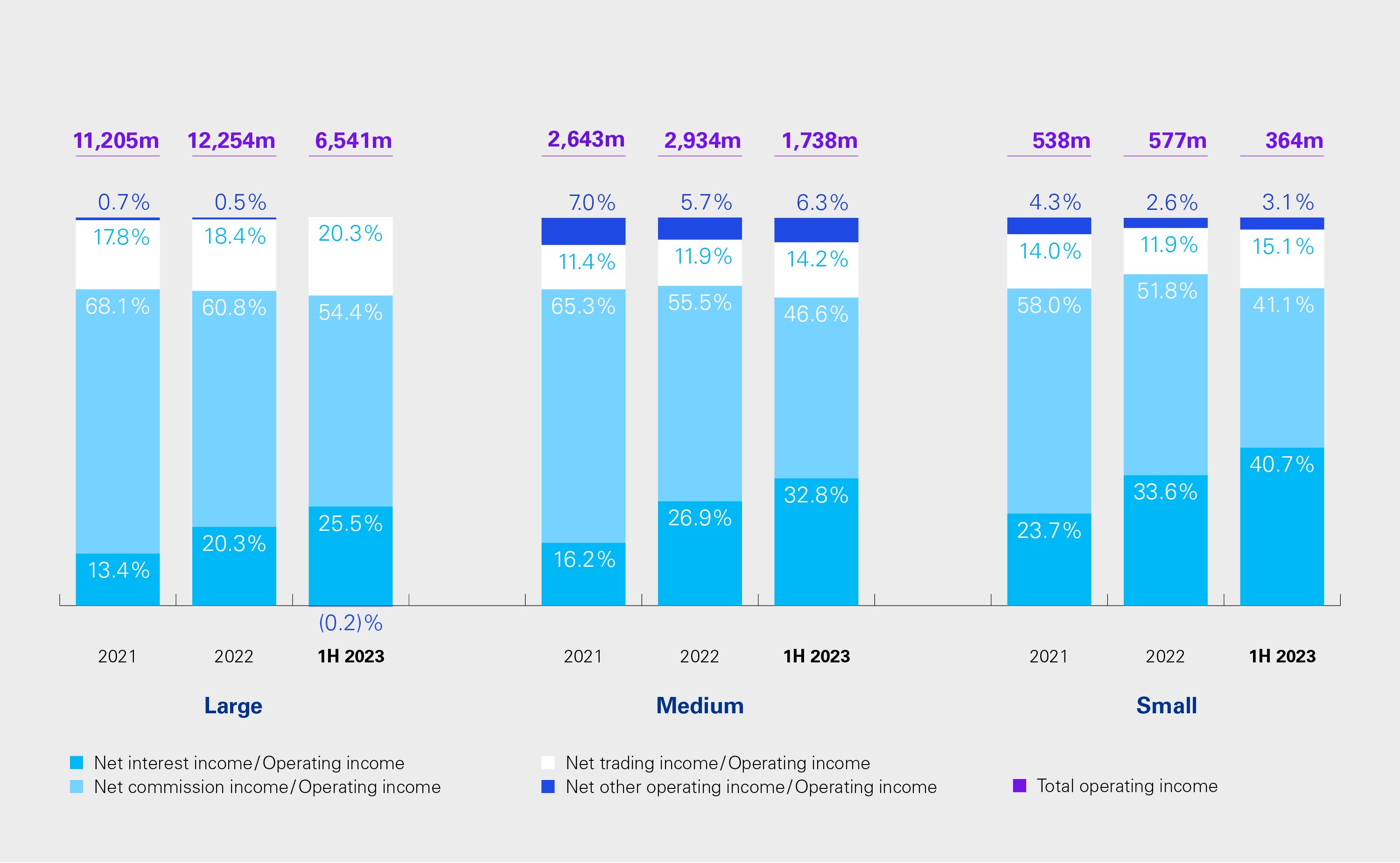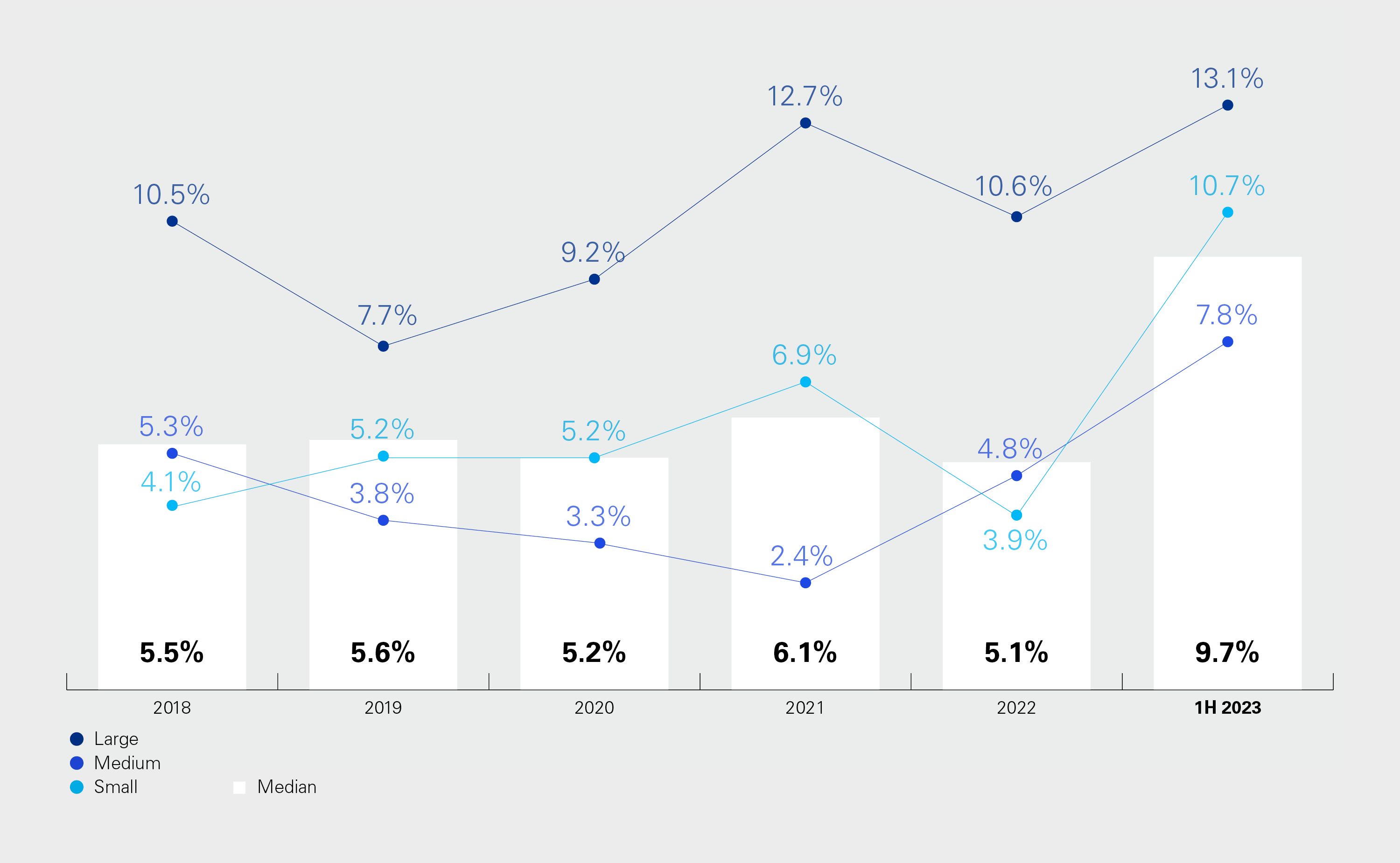Impressive performances by Switzerland’s small private banks
Small banks thrived in the first half of 2023, as gross profits soared to reach the levels achieved for the whole of 2022. Their median C/I improved too, by 13.3 percentage points, from 78.6% to 65.3%. On top of this, small banks improved their RoE more than any other size cluster, to 10.7%. This is a marked improvement from 2022, when they were the weakest cluster with a median RoE of 3.9%.
Although just under half the sample size of our full-year study, and with many of the weakest banks not reporting their half year results, this shows the remarkable turnaround of Switzerland’s smaller banks in the past year, while the country’s large banks continued to perform strongly.
Basis of preparation We analyzed the 2023 half-year results of 37 Swiss private banks published on the bank’s website or at the Swiss Official Gazette of Commerce SOGC. This represents 42% of the population of 89 Swiss private banks. This financial information does not include AuM and NNM figures. Our analysis covers 75% of large banks (AuM > CHF 100bn), 52% of medium-sized banks (AuM CHF 10-100bn) and 32% of small banks (AuM < CHF 10bn). The 37 banks’ results compare to 73 banks in our Clarity on Swiss Private Banks 2022. In our sample of 37 banks, many of the weak performers in 2022 are missing, as they didn’t publish their half year results for 2023. Our analysis also excludes UBS, Credit Suisse and banks in liquidation. |
The highest ever number of strong performers as cost-income (C/I) ratio falls dramatically
The number of strong performing banks rose to 21 in 1H 2023, from 12 in 2022. Following many years of stability, the median C/I fell by a dramatic 10.4 percentage points. The C/I at the best performing bank was 32%, a level never seen among Swiss private banks. More than half of our sample of 37 banks recorded a C/I of less than 70%, which is also a new record.
This strong performance was driven by interest rate developments across major currencies, and greater trading activity. While financial markets recovered slightly in in the first half of 2023, net commission income fell by 4.5% compared to 2022 at the large banks and remained stable at other banks. It therefore did not contribute to the strong overall performance and indicates that the industry’s AuM did not change much. While we do not have AuM figures for most banks, we see a slight rise in AuM at some of the large banks where figures are available.
Small banks performed most impressively
Small banks thrived in the first half of 2023, with gross profit almost reaching full-year 2022 levels. Their median C/I improved by an impressive 13.3 percentage points, from 78.6% to 65.3%. These developments helped six small banks to join the cluster of strong performers this year.
Five of the six large banks in our sample are strong performers. Their median C/I improved however only slightly, by 1.3 percentage points to 67.3%. This is the first time it is higher than that of small banks.
Medium banks’ C/I fell by 7.4 percentage points to 74.2%, which is much higher than at large and small banks.
Driving these different developments is that large banks and mid-sized subsidiaries of global banks generally pay much higher interest to clients and therefore have much higher funding costs than small banks. All except one large bank in our sample, and most subsidiaries of foreign banking groups, pay 1.3% to 3.5% on their funding. The median at small banks is 0.2%.
As large banks and subsidiaries of foreign banks generally have a much more international client base and often larger clients, they may be under greater pressure from clients and competitors to raise the interest rates they pay. Some small banks, by comparison, focus on Swiss clients who operate in the Switzerland’s far lower interest rate environment.
Interest income has become a key source of income
Small and medium-sized banks have seen a significant shift in their revenue mix. They no longer rely predominantly on net commission income, which has fallen significantly as a share of total operating income, as the share of net interest income has grown. They also recorded a significant increase in trading income, which may be driven primarily by greater foreign exchange activities as their clients seek to benefit from higher interest rates in USD.
While net interest income contributed more to large banks’ operating income in 2023, it still represents only about one-quarter of their operating income in the first half of 2023. 54% of operating income is derived from net commission income, highlighting the focus on asset and wealth management.
Median RoE surges to 9.7%
The median return on equity for the 37 banks leapt to 9.7% in the first half 2023, following five years of stable rates of around 6%. This was for all size and performance clusters. Small banks improved their RoE most, however, to reach 10.7%. This is a remarkable development, considering they were the weakest cluster in 2022 when their median RoE was 3.9%.
Consolidation halted
As Banque Havilland (Suisse) became a branch as part of a group reorganization, the number of Swiss private banks fell slightly to 89, from 90 at the end of 2022.
This reflects an almost complete cessation of M&A activity in the first nine months of 2023, at only two transactions excluding the merger between UBS and Credit Suisse. Reyl acquired Carnegie Fund Services, a Swiss fund representative in June 2023, and UBP acquired Angel Japan Asset Management with around CHF 1.1bn in AuM.
Independent Asset Managers (IAMs) were more active, with eight transactions in the first nine months of 2023. Three involved private equity firms, and others saw IAMs expand their service offering by acquiring other financial service companies and family offices. There was one consolidation deal between two IAMs.
We assume low activity levels may continue until early 2024, though we already see some deals coming to market and note significant interest by many players in undertaking acquisitions. While many banks seek to benefit from the integration of Credit Suisse into UBS by hiring relationship managers, we expect a rebound in M&A activity going forward. Increased profitability will also make it easier for sellers to go to market anticipating a more attractive valuation. Banks that continue to search for profitable growth will play an important role.
Outlook
We expect very strong performances to continue at those banks that benefited most in the first half year from interest rate changes. The more negative financial markets in the second half year will lead to more cautious clients, which will make NNM generation more difficult and will most likely cause AuM and commission income to decline. While we can expect record results from small banks in particular, it will be very tough for banks’ core wealth businesses.






